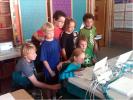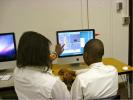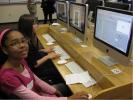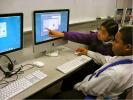Combining Peer Mentorship and Team Teaching: An Interview with Chris Myers and Lindsay Allen of Myers Learning
Chris Myers and Lindsay Allen are committed to supporting learning through peer mentorship and team teaching, and according to Chris, an educator of Logo, MicroWorlds, and Scratch for over 20 years, it all started with a bird.
From his experience as a classroom teacher, “The peer mentoring was purely born out of necessity. I used to call it ‘the bird,’ that when I turned around, I’d feel two or three fingers pecking at my back asking for help. I thought, ‘I can’t possibly help all these students. Maybe I better deputize a few that have been here a few more weeks than the others to help me with the new students.’ ”
Chris and Lindsay are now expanding this concept of peer mentorship through Myers Learning, their company based in Denver, Colorado that offers Scratch after school programs, school-day electives, educator workshops and more. The aim is “to create powerful ‘learning communities’ — in which each student, and each adult, is both a teacher and a learner.” They are expanding the mentorship landscape on many levels by developing a framework that integrates both students and teachers as supporters of others’ learning not simply as a sum of multiple parts, but cohesively as an ensemble cast. As opposed to a basic one-way, mentor-to-student relationship that is typical of most peer mentoring strategies, they have developed a model that is more about fostering a culture than assigning individual responsibility. “We emphasize that we are all mentors. Sometimes we might be mentoring people, and sometimes they might be mentoring each other, and other times, they might be mentoring us. Team teaching is at all levels.”
.jpg)
(Mentors, Kazzie and Juan, working together. In the background are Chinh Hao, an adult volunteer with programming background, and Steve Larson, a Venture Prep teacher who is part of our teaching team for the after-school Scratch Elective offered Mondays and Wednesdays. We have 7 mentors who we meet with every Tuesday for Mentor Day. On Mondays and Wednesdays, they work on their own projects and also mentor other students.)
Chris and Lindsay regularly explore, tinker, and put themselves in the learner’s position. As Lindsay describes in one example, “I think the most effective thing is that when we have enough teachers or volunteers or mentors, then one of us can just sit down and start working in Scratch. Students tend to walk by and be really interested and curious in what you’re doing, and that sparks a lot of collaborative projects. I know the times I’ve been able to sit down and work, students come by and say, ‘I have a great idea about what you could do next in that project.’ An effective way of teaching is just working on it ourselves, and that gets kids excited. They love seeing that teachers are sitting down and doing the same thing that they’re being asked to do.” Chris agrees. “If you sit down and concentrate and focus, you discover all kinds of marvelous things like, ‘Wow, you really do spend quite a lot of time thinking,’ and the next time you go over to a student, you’re going to be a lot more warm and receptive to the idea that they’re waiting for inspiration to strike because just five minutes ago you were doing just that. So the peer teaching is important in that it begins to free up the teacher to play a role that’s more similar to the core role that teachers ask students to play.”
.jpg)
(Lindsay showing one of her projects.)
Although these two admit that fostering this kind of vulnerability in teachers can be difficult, Chris thinks that it’s an important part of building a learning community. “It’s amazing how students respond when the adult is willing to be publicly stuck and confused and ask for help. It opens up this huge territory. I remember, about ten years ago, I had a kid who really wasn’t willing to learn anything from me in terms of computer programming. One day, it was discovered that I didn’t know how to use a fax machine. I asked this student if he wouldn’t mind showing me. He showed me and was extremely skillful. The very next day, he wanted to learn computer programming. When it comes to teaching and learning, we should be able to step out of that role of always having to be the expert.”

(Venture Prep Teaching Team gathered around student, Saxon Cooper, who has created a character whose lips moves when he talks. Left is Lindsay Allen. Center is Chris Myers. Standing is Steve Larson.)
Participating as both mentors and learners keeps Chris and Lindsay busy, as do their expanding activities with Myers Learning. Yet, envisioning a new construct for teaching and learning is their passion, and their enthusiasm for students, thoughtful pedagogy, and consideration towards others are recognizable. Lindsay explains. “I think at this point, our students have really caught on to the fact that we enjoy learning when they know things that we haven’t discovered yet. So I think they’ve kind of gotten the idea that it’s fun to share in that way and help each other, and that they’re not overstepping bounds if they give us some ideas.”





